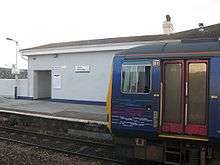Exeter St Thomas railway station
Exeter St Thomas railway station is a suburban railway station in Exeter, England, serving the suburb of St Thomas and the riverside area. The station is elevated on a low viaduct with entrances on Cowick Street.[2] It is 74 chains (1.5 km) down the line from Exeter St David's and 194 miles 66 chains (313.5 km) measured from London Paddington via Bristol Temple Meads.
| Exeter St Thomas | |
|---|---|
.jpg) | |
| Location | |
| Place | St Thomas, Exeter |
| Local authority | Exeter |
| Coordinates | 50.71713°N 3.53858°W |
| Grid reference | SX914919 |
| Operations | |
| Station code | EXT |
| Managed by | Great Western Railway |
| Number of platforms | 2 |
| DfT category | F1 |
| Live arrivals/departures, station information and onward connections from National Rail Enquiries | |
| Annual rail passenger usage* | |
| 2014/15 | |
| 2015/16 | |
| 2016/17 | |
| 2017/18 | |
| 2018/19 | |
| History | |
| Original company | South Devon Railway |
| Pre-grouping | Great Western Railway |
| Post-grouping | Great Western Railway |
| Opened | 1846 |
| Listed status | |
| Listed feature | Exeter St Thomas railway station |
| Listing grade | II |
| Entry number | 133347[1] |
| Added to list | 18 June 1974 |
| National Rail – UK railway stations | |
| |
The station is unstaffed with the former station building now used for a bar and nightclub. It is mainly served by local trains operated by Great Western Railway. It is the only station in Exeter which is listed (Grade II).[1]
History
The station was opened on 30 May 1846 by the South Devon Railway.[3] The company had joint use of the Bristol and Exeter Railway station at St David's but St Thomas was its own station. Although built on a 501 yards (458 m) stone viaduct, the railway was nearer to the city centre and the quays on the Exeter Canal. Until 1862 tickets were only sold between St Thomas and stations west of Exeter, not to St David's and the north.[4]
The railway was worked by atmospheric trains from 13 September 1847 until 9 September 1848. Unique in all the South Devon Railway stations, there was no engine house, so the driver had to hold the train on its brakes against the pressure in the pipes while it was stopped here.[5]
The original station featured just a single track with a 175 feet (53 m) platform on the city side of the line. A small booking office was built at road level at the north end of the station and steps led up to the platform. The viaduct was widened at this point by five feet to accommodate the platform.
In 1847 some improvements were completed including a larger office, a train shed over the platform, and an extension to bring the platform to a length of 260 feet.
In 1851 George Hennet was given permission to build a coal depot at St Thomas from where he could distribute coal, brought by train from his quay at Teignmouth. This was built on the city side of the line, north of the station. Hennet died in 1857 and the depot was eventually taken over by Robert Ward. It was closed in 1884 but Ward continued to use the land as premises until c. 1930. The site is now occupied by the Great Western Railway Staff Association staff club.
In 1861 the viaduct was widened on the west side (away from the city), and a second track brought into use which necessitated a second platform be built. Elegant new two-storey buildings were built on the city side of the viaduct, and a new train shed built across both platforms.
The train shed was demolished in the 1960s and the station is now unstaffed. The 1861 building was previously used as a Chinese restaurant and a nightclub. Since 2015 the building stands derelict and has fallen into disrepair with the doors and windows boarded up.
The station was proposed for closure in Dr. Beeching's The Reshaping of Britain's Railways report but has remained open.[6]
Services
Exeter railway stations | |||||||||||||||||||||||||||||||||||||||||||||||||||||||||||||||||||||||||||||||||||||||||||||||||||||||||
|---|---|---|---|---|---|---|---|---|---|---|---|---|---|---|---|---|---|---|---|---|---|---|---|---|---|---|---|---|---|---|---|---|---|---|---|---|---|---|---|---|---|---|---|---|---|---|---|---|---|---|---|---|---|---|---|---|---|---|---|---|---|---|---|---|---|---|---|---|---|---|---|---|---|---|---|---|---|---|---|---|---|---|---|---|---|---|---|---|---|---|---|---|---|---|---|---|---|---|---|---|---|---|---|---|---|
| |||||||||||||||||||||||||||||||||||||||||||||||||||||||||||||||||||||||||||||||||||||||||||||||||||||||||
Most trains are operated by Great Western Railway on the Riviera Line to and from Paignton which then generally continue east of Exeter St David's to and from Exmouth along the Avocet Line. A few other services operate to destinations further afield such as Bristol Temple Meads, Plymouth and Penzance, with one direct service a day to and from London Paddington.[7]
| Preceding station | Following station | |||
|---|---|---|---|---|
| Exeter St Davids | Great Western Railway Riviera Line |
Starcross | ||
References
| Wikimedia Commons has media related to Exeter St Thomas railway station. |
- Historic England. "St Thomas Railway Station (1333347)". National Heritage List for England. Retrieved 20 July 2016.
- Oakley, Mike (2007). Devon Railway Stations. Wimbourne: The Dovecote Press. ISBN 978-1-904349-55-6.
- MacDermot, E T (1931). History of the Great Western Railway, volume II 1863-1921. London: Great Western Railway.
- Kay, Peter (1993). "The First St Thomas". British Railway Journal. Wild Swan Publications (45): 244–254. ISSN 0265-4105.
- Kay, Peter (1991). Exeter - Newton Abbot: A Railway History. Sheffield: Platform 5 Publishing. ISBN 1-872524-42-7.
- The Reshaping of British Railways (PDF). London: British Railways Board. 1963. p. 113.
- "London and Birmingham - Devon and Cornwall" (PDF). National Rail Timetable. Network Rail. Archived from the original (PDF) on 26 September 2015. Retrieved 4 September 2015.
Further reading
- Beck, Keith; Copsey, John (1990). The Great Western in South Devon. Didcot: Wild Swan Publication. ISBN 0-906867-90-8.
- Cooke, RA (1984). Track Layout Diagrams of the GWR and BR WR, Section 14: South Devon. Harwell: RA Cooke.
